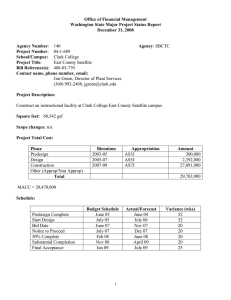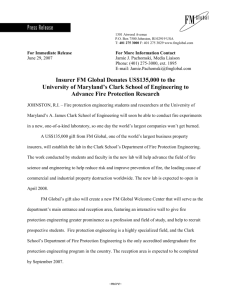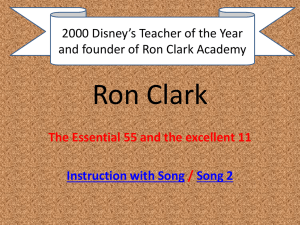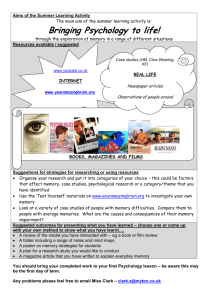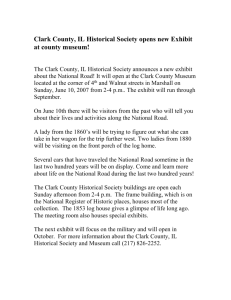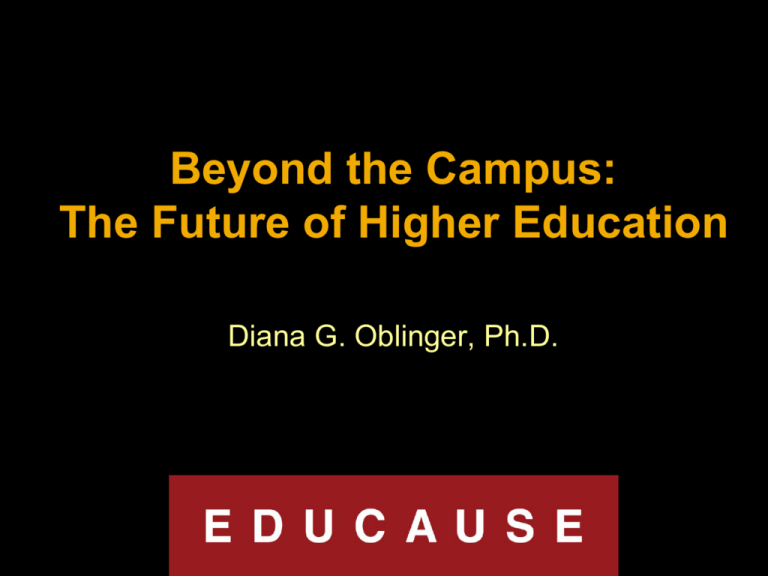
Beyond the Campus:
The Future of Higher Education
Diana G. Oblinger, Ph.D.
Current Environment
Educational imperative
• By 2025 60% of the American population should
hold college degrees or credentials
• Benefits health, civic engagement society
• Post-secondary education
is the new baseline
• “Boosting our college
completion rate from 25%
to 27.5% would yield a full
1% increase in real GDP
per worker, or about $125
billion for the US
economy.”
College completion
• Average 6-year completion rate (4-year
institutions): 56%
• Average 3-year graduation rate (community
colleges): 22%
• Percentage of 26-year
olds with postsecondary
credential: 44%
• Percentage of lowincome 26-year olds with
credential: 26%
Cost, demand and funding
•
•
•
Costs for education rising
Demand for education
growing worldwide
Funds
Government funding
declining (competition with
medical care, other
programs); global economic
downturn
Costs
Demand
Economic sustainability
• Economic model of higher education may not be
sustainable
• Competition for funds with
―Health care
―Social security
―Other social
programs
Can we make it?
•
•
•
•
•
•
Instructional and other educational expenditures in
public higher education: $151 billion
Just to maintain current net tuition levels and
enrollment, HE needs an additional $30 billion in
state appropriations in 2020
Over past decade, state appropriations for higher
education have declined
State and local health care expenditures are expected
to rise by $103 billion over the next decade
Is $30 billion from the states plausible?
$30 billion would require doubling tuition
—Convening, 2010
Cost containment options
• Restructuring employee benefits
• Consolidation of operations and activities
• Increase academic productivity
― Reduce time-to-degree
― Improve performance
monitoring/intervention
― ROI of student support
services
― Alternate academic
delivery models
—Wellman, 2010
The future is already
here….
Emerging educational environment
• Learners have almost unlimited access to
content, tools, resources, faculty, experts
• Unbundling of educational activities
• Importance of “the collective” is growing
• New models gaining adoption
Access to resources
• Digitized and indexed books (28 million
volumes)
•
•
•
•
Data, archives
Access without need to maintain
collections on campus
New tools for scholarship
(e.g., text analysis)
Use of “consumer”
channels
Unbundling
•
•
•
•
Tutoring and mentoring
Available on demand, 24x7
Matches mentors and
mentees; flexible scheduling
Shared live experiences;
whiteboarding
Collaboration
• CaBIG
• Virtual network of interconnected data, individuals and
•
organizations whose goal is to redefine how research
is conducted, care is provided and patients interact
with biomedical research enterprise
―Adapt or build tools to collect, analyze, integrate
―Connect cancer research community through
sharable, interoperable digital infrastructure
―Deploy and extend standards and common
language
Community of 1,000+ individuals
and 190+ institutions
—image from NSF
New models
• Applications in the “cloud”
• Access more important than ownership
• Individuals choose what they want;
applications and services are publicly
available
•
Many available on-demand
Imagine the impact
Educational investments
Cognitive Task
Analysis (CTA)
CTA for program design: $20,000
CTA for course design: $5,000
Interactive Media
Java and Flash-rich training: $5,000+ per hour of
instruction
Complex simulations: $25,000+ per hour of
simulation
Platforms
Adaptive e-learning platform development: $1020M (5 years)
—Saxberg, 2010
Benefits of CTA
Efficiency
Engagement
Effectiveness
Reduce time and
materials by 20%
Reduces attrition (e.g.,
50% in Chemistry)
Reduces 1st year onthe-job error rates
Faster and simpler to
keep training up-to-date
Provides rigorous basis
for counseling
Clear link from work
success to training
—Saxberg, 2010
Adaptive testing
• Knewton: adaptive testing for LSAT and GMAT
• Personalized learning plan constantly recalibrated
based on results
•
•
Daily, unique learning plan developed daily,
tailored to:
―Concept
―Difficulty level
―Media type
―Calendar (hours you
plan to study, hours
you are available)
Live, virtual classrooms
(also archived)
Impact
What would the impact be, financially and in
terms of opportunity cost, if….
• …you could reduce time-to-degree by one
semester
• …you could reduce the cost per semester by
one course
• …you could personalize learning to the needs
of the student
Open educational resources
•
•
Flat World Knowledge;
free, peer-reviewed
textbooks online
Build-a-book, community
tools; notetaking
•
•
Open
educational
resources
Share, modify
Impact
If you could invest the cost of textbooks
elsewhere….
• …Current textbook market is estimated at $8.2
billion (over $9 billion by 2014)
• …assume $100 per textbook for English
composition; 46,000 students/year
• …where might you invest $4.6 million on
behalf of your students?
—Green, 2010
(figures for Washington State Technical Colleges)
Analytics
• Large data sets; data extraction
• Data warehousing
• Statistical techniques
• Predictive modeling
• “Actionable intelligence”
• Uses:
―Student recruitment
―Student retention
Impact
If you could monitor student progress what
impact might that have….
• …if a student knew to change his/her study
habits before receiving a low test score
• …if a faculty member had enough information
on when and how to effectively intervene
• …if an advisor could interrupt recurring
patterns of failure
New Models
StraighterLine
•
•
•
•
Required college courses
Start any time; no required meeting times
Individualized, on-demand support (online)
Transfer credits to partner college(s)
Peer 2 Peer University
•
•
•
•
•
•
Enable communities of people to support learning
for each other
Open educational resources, structured courses
Run and governed by volunteers
Learning groups: 8-14 people
Peers in the courses
assess each other’s work
Online certificates of
completion
WGU
•
•
•
•
•
•
Credit for prior learning; competencies developed with
industry experts
Objective and performance-based assessment of
competencies
WGU faculty identify best
existing courses; acquire
rights to use them
Faculty serve as mentors,
also peer mentoring
Accelerated degree
options
30% growth rate
Higher education as a gateway
• Colleges and universities represent 35% of the
entire postsecondary education and training
system
•
•
•
•
On-the-job training
Employer education
Military training
Apprenticeships
• HE provides entry to jobs
with greatest access to
employer-provided training
• Training can increase
earnings 3-11%
—Carnevale, et al., 2010
BYU-Idaho
• Three imperatives
―Improve every aspect of the student
experience
―Serve more students
―Lower the relative cost of education
• Strategic initiatives
―New academic calendar
―Learning model
―Online learning
—Clark, 2010
Academic changes
• Three semesters
• Three track admission system
• Academic day: 7:45 am – 5:30 pm
• Classes: 60 minutes
• Average class size: 30
• Maximum class size: 85
• No differential rank among faculty
—Clark, 2010
Learning model
•
•
•
•
•
Push the edge of current understanding
Seek truth and recognize the value of all
sources of new insight, knowledge, and
understanding
Pursue education as a developmental
experience for the whole person
Act for themselves and accept responsibility
for learning and teaching
Respect, serve, and teach each other
—Clark, 2010
Online/hybrid model
Online/hybrid courses
―Designed to learning model principles
―Cohort and semester-based
―Learning teams
―Skilled instructors (remote adjunct)
Integrated curriculum
―Designed/developed by faculty on campus
―Same courses delivered on and off campus
Increase on-campus capacity
―Target: 20% of student credit hours online by 2012
—Clark, 2010
Enrollment growth
25000
BYU-Idaho Unduplicated Headcount
22997
23000
21820
21000
20130
19000
17385
17000
15410
15000
14892
14874
13000
1998
1999
2000
2001
2002
2003
2004
2005
2006
2007
2008
2009
—Clark, 2010
Total operating cost per FTE student
$9,000
$8,000
$7,000
111
109
$6,000
104
106
105
105
101
100
105
106
2009
2010
102
$5,000
$4,000
1996- 199797
98
1999
2000
2001
2002
2003
2004
2005
2006
2007
2008
Projected
Total Operating Expenditures per Student FTE in 2000 Constant $$s
—Clark, 2010
“Game Changers”
The network
• Everything (and everyone) is interconnected
• Internet provides an architecture for
participation and collaborative creation
• Society benefits from
small, cumulative
contributions of millions
of people
• Use by everyone does
not exclude use by
anyone
—Digital Connections Council, 2006
—image credit
Collective intelligence
•
•
•
•
•
•
Knowledge is created not possessed
Shift in emphasis, e.g., wikipedia is a process not a product
Collective intelligence: everyone has something to contribute
Social connections
are important
Openness; sharing
Traditional barriers
become permeable
—Jenkins, 2008
From campus to “the cloud”
Cloud layer
IT infrastructure
IT services
IT support
Consumer layer
1990
2000
2010
2030
--Katz, 2009
Worth Considering
Helping students
graduate from college
takes 16 years, not 4
years.
Learning should be part
of your life, not an
episode in your life.
You learn to do
what you do.
College is what students
experience.
doblinger@educause.edu
© 2010 All rights reserved


